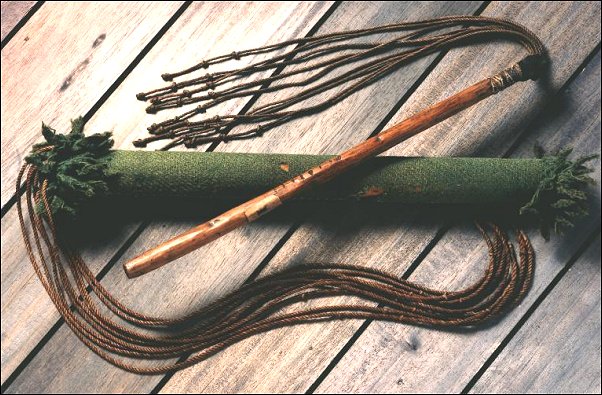|
Life
in the Royal Navy of the 18th and 19th centuries was very rough
indeed. The living accommodation was often sordid and at best uncomfortable,
the food was awful to the point of leading to such diseases as scurvy,
and the danger in time of battle was considerable. Finally, discipline
was, to say the least, robust, as evidenced by these fearsome instruments
of punishment.
Perhaps
not surprisingly, common sailors were far from eager to join up,
particularly when war threatened. The navy had to resort to using
the press gang to forcibly enlist men, particularly during the Napoleonic
Wars. To help ensure a ready supply of trained men for pressing
into service, the government heavily subsidized the whaling industry.
Peterhead whalers were not immune; the press gang from the frigate
H.M.S. Circe took two men from the Robert in 1790
and another three in 1796.

©SCRAN/National
Museums Scotland.
Cat o' 9 tails
|
These
cats of nine tails were used around 1840 for flogging. The larger
one was used in the navy, the smaller one in the British army. Both
were collected for a special teaching museum for military surgeons
set up in the University of Edinburgh in 1843.
A
key duty of both naval and military surgeons was to supervise floggings
to ensure that the offender’s life was not put in danger. Yet it
was not unheard of for a man to die as a direct result of this punishment.
Flogging was long used as the principal means of punishment in both
the navy and army. The instrument used in the army was, however,
smaller and inflicted less injury.
The
cat was specifically designed to cut the back of the offender. A
ship’s captain had authority to inflict a punishment of up to 48
lashes for a single offence. A court martial could hand down sentences
of up to one thousand lashes in exceptional cases. Flogging has
never actually been abolished in the Royal Navy, although it has
been suspended since 1879. It was abolished in the army in 1881
after a long political campaign that argued it was inhuman and discouraged
recruiting.
Traditionally,
the army imposed larger numbers of lashes, spread - if necessary
- over a long period, since the incapacity of a sailor by a large
number of lashes might impede the efficient running of his ship.
High sentences in the Navy were thus only carried out when the offender’s
ship was in port, and he could, as an example, be ‘flogged around
the fleet’.
|